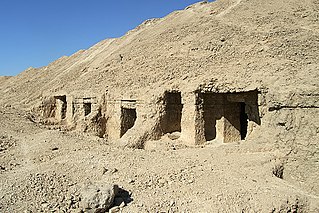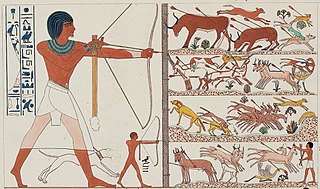
The necropolis of Draʻ Abu el-Naga' is located on the West Bank of the Nile at Thebes, Egypt, just by the entrance of the dry bay that leads up to Deir el-Bahari and north of the necropolis of el-Assasif. The necropolis is located near the Valley of the Kings.
Naguib Kanawati is an Egyptian Australian Egyptologist and Professor of Egyptology at Macquarie University in Sydney, New South Wales, Australia.

El Hawawish is the ancient necropolis (cemetery) for the city of Akhmim in the 9th Nome of Upper Egypt (UE09), in modern the Sohag Governorate, Egypt.

The Theban Tomb TT16 is located in Dra' Abu el-Naga', part of the Theban Necropolis, on the west bank of the Nile, opposite to Luxor. It is the burial place of the ancient Egyptian Panehsy, who was Prophet of Amenhotep (I) of the Forecourt, during the reign of Ramesses II.

The Theban Tomb TT147 is located in Dra' Abu el-Naga', part of the Theban Necropolis, on the west bank of the Nile, opposite to Luxor. It is the burial place of an Egyptian called Neferrenpet, who lived during the reign of Amenhotep III.
in Ancient Egypt, Paser II was the son of the High Priest of Min and Isis named Minmose. Paser came from a very well-connected family. One uncle was the High Priest of Amun Wennenefer and another uncle was the troop commander of Kush named Pennesuttawy. Through Wennenefer, Paser was related to Amenemone, Amenemope and Hori, the High Priest of Anhur.
Parennefer also called Wennefer was a High Priest of Amun during the reigns of Tutankhamun and Horemheb. He was previously thought to date to the time of Ramesses II, but he is now dated to the end of the Eighteenth Dynasty. Parennefer was more firmly put at the end of the Eighteenth Dynasty after extensive excavations of his tomb in Thebes in 1990–1993.

The Theban Tomb TT19 is located in Dra' Abu el-Naga', part of the Theban Necropolis, on the west bank of the Nile, opposite to Luxor. It is the burial place of the ancient Egyptian Amenmose, who was the high priest of Amenhotep of the Forecourt during the early Nineteenth Dynasty.

The Theban Tomb TT156 is located in Dra' Abu el-Naga', part of the Theban Necropolis, on the west bank of the Nile, opposite to Luxor. It is the burial place of the ancient Egyptian Pennesuttawy, who was a troop commander and superintendent of the Southern Desert Lands during the reign of Ramesses II in the Nineteenth Dynasty.
This page list topics related to ancient Egypt.
Sennedjem was a high ancient Egyptian official living under King Tutankhamun at the end of the 18th Dynasty. Sennedjem was overseer of tutors but also bore several other titles, such as the father of the god, beloved of the god, and fan-bearer on the right side of the king. Sennedjem is so far only known from his decorated tomb at Akhmim. Today, The tomb is heavily destroyed, and much of the decoration is lost. It was never finished, and it is uncertain whether Sennedjem was ever buried here.

TT233 is the tomb of Saroy and Amenhotep located at Dra Abu El Naga in Egypt

Mehu was an Ancient Egyptian vizier who lived in the Sixth Dynasty. The office of the vizier was the most important one at the royal court. Mehu is mainly known from his monumental mastaba at Saqqara, not far away from the Pyramid of Unas.
Anhurmose was an ancient Egyptian official of the New Kingdom. He was the high priest of Anhur under Merenptah, but started his career as a military man, most likely under king Ramesses II.
Imiseba was an ancient Egyptian official of the 19th Dynasty in the Ramesside Period. He is mainly known from his decorated rock cut chapel at Lepidotonpolis. He had several important titles, including true scribe of the lord of the two lands and chief archivist of the lord of the two lands. These are evidently important functions at the royal court. The lord of the two lands was the king. Perhaps later in his career he took over some functions in the temple administration. He became high steward in the domain of Khonsu and high steward of Khons.

Tomb TT374, located in the necropolis of El-Khokha in Thebes, Egypt, is the tomb of the Scribe of the Treasury of the Ramesseum, Amenemope.

Tomb A.6 is the modern number given to a now lost Theban tomb in Dra' Abu el-Naga'. The burial dates to the ancient Egyptian 18th Dynasty and belonged to the overseer of the marshland dwellers Dhjehutinefer, who is also called Seshu. The place was visited by the expedition of Karl Richard Lepsius, who copied the tomb owner's title overseer of the marshland dwellers of the lord of the two lands, but not the name. It seems that the tomb was then already heavily destroyed. Before 1906 the French Egyptologist Henri Gauthier visited A.6 and described the few remains of the decoration and published a short note. Gauthier recorded some further titles of Dhjehutinefer, such as scribe and counter of cattle and fowl of the temple of Amun. A fragment belonging to the tomb is a wall painting that is today in the Metropolitan Museum in New York. On the fragment in New York also mentioned the wife of Djehutinefer, a woman called Benbu. Several funerary cones belonging to the tomb are known. They provide the name of Djehutynefer's father who was the scribe Mesu.

Tomb A.5 is the modern number given to a now lost Theban tomb in Dra' Abu el-Naga'. The burial dates to the Ancient Egyptian 18th Dynasty and belonged to the overseer of the granary of the Lord of the Two Lands, Neferhotep. The tomb was visited by the French traveller Frédéric Cailliaud, who copied and published several scenes. Evidently, he saw the tomb in a fairly good condition and was described by others as superb. The location of the tomb got lost within the Nineteenth century. According to the old drawings published., there are several scenes depicted in the tomb. These include both hunting in the marshes and hunting in the desert, a banquet, and scenes showing vintage and agriculture.










